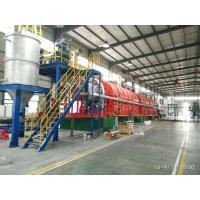| Sign In | Join Free | My himfr.com |
|
| Sign In | Join Free | My himfr.com |
|
| Ask Lasest Price | |
| Price : | Negotiable |
| Payment Terms : | Negotiable |
The cement industry is continuously evolving, driven by the need for more efficient, cost-effective, and environmentally friendly solutions. One of the most significant advancements in this field is the development of advanced cement rotary kiln technology. These state-of-the-art kilns are designed to offer precision control, high productivity, and eco-friendly operation, making them an essential component in modern cement production. This article delves into the features, applications, and common questions regarding advanced cement rotary kiln technology.
Precision Control
High Productivity
Eco-friendly Operation

Cement Manufacturing
Metallurgical Processes
Environmental Applications
1.What is the main advantage of advanced cement rotary kiln
technology over traditional kilns?
The main advantage is the enhanced precision control, which allows
for consistent product quality, higher productivity, and
eco-friendly operation. Advanced rotary kilns use state-of-the-art
sensors and automated systems to optimize every aspect of the
production process.
2.How does precision control improve cement production?
Precision control ensures that the kiln operates within the optimal
temperature and pressure ranges, which leads to uniform clinker
quality, reduced waste, and lower energy consumption. It also
allows for immediate adjustments in response to real-time data,
enhancing overall efficiency.
3.Can advanced rotary kilns reduce operational costs?
Yes, these kilns are designed to be energy-efficient, which reduces
fuel consumption and operational costs. Additionally, their robust
construction and advanced monitoring systems minimize maintenance
requirements and downtime, further contributing to cost savings.
4.What makes advanced rotary kilns eco-friendly?
Advanced rotary kilns are eco-friendly due to their efficient
combustion processes that minimize harmful emissions, incorporation
of waste heat recovery systems, and the use of sustainable
materials in their construction. These features help reduce the
environmental footprint of cement production.
5.Are there any specific maintenance requirements for advanced
rotary kilns?
While advanced rotary kilns are designed for durability and low
maintenance, regular inspections and maintenance are essential to
ensure optimal performance. This includes checking sensor
calibrations, inspecting refractory linings, and ensuring the
proper functioning of automated control systems.
6.Can these kilns be used for applications other than cement
production?
Yes, advanced rotary kilns are versatile and can be used in various
industries, including metallurgy for lime calcination and
refractory material production, environmental applications such as
waste incineration and soil remediation, and the production of
specialty cements.
7.What is the typical lifespan of an advanced rotary kiln?
The lifespan of an advanced rotary kiln depends on various factors,
including the operating conditions, maintenance practices, and the
materials used in construction. However, with proper care, these
kilns can operate efficiently for several decades.
8.How does waste heat recovery work in rotary kilns?
Waste heat recovery systems capture excess heat generated during
the kiln's operation and reuse it for other processes, such as
preheating raw materials or generating electricity. This not only
improves energy efficiency but also reduces overall energy
consumption.
9.What types of emissions control technologies are used in advanced
rotary kilns?
Advanced rotary kilns use various emissions control technologies,
including selective non-catalytic reduction (SNCR) and selective
catalytic reduction (SCR) for NOx reduction, and advanced scrubbers
and filters for controlling particulate matter and other
pollutants.

|




